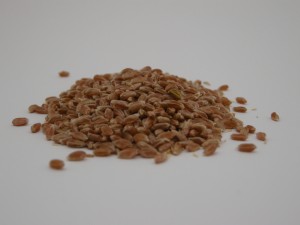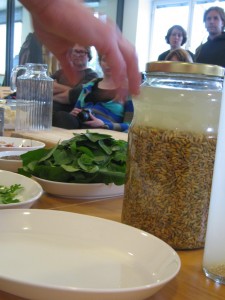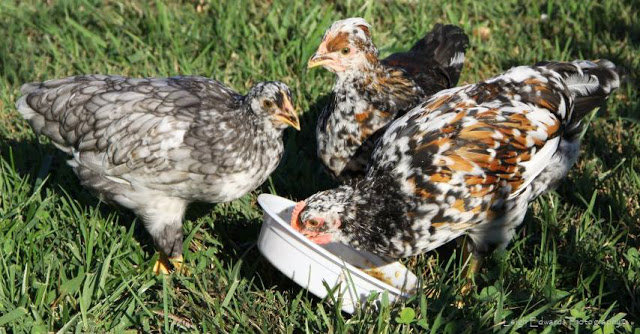Fermenting certain foods is a very traditional method of food preservation and also enhancing nutrition. When it comes to feeding our backyard flock, fermentation is an excellent method to improve the diet and health of our flock through improving the gut chemistry of our birds.
Today’s guests on the Urban Chicken Podcast are Leigh Edwards and Sue Strantz – both experts in holistic, natural chicken keeping. Leigh and Sue join me on the show to discuss all of the ins and outs of how to properly ferment various types of chicken feed.
Leigh Edwards and Sue Strantz are seasoned at the practice of fermenting chicken feed for their flocks. The reason they both bother to go through the process of fermenting their chickens’ feed is to improve the nutritional value of the feed, to improve their bird’s digestion and to save money on feed.
 Not all of the nutrition in food is actually available for absorption upon consumption. Grains and legumes in particular are designed to “pass-through” the creature eating them and come out the other side still fully able to sprout, if possible. Consequently, grains and legumes are naturally protected by anti-nutrients, which act to save the viability of the seed of grain or legume by prohibiting the creature from eating them from being able to physically access their nutrients (i.e. stored fats, proteins and minerals) during the digestive process.
Not all of the nutrition in food is actually available for absorption upon consumption. Grains and legumes in particular are designed to “pass-through” the creature eating them and come out the other side still fully able to sprout, if possible. Consequently, grains and legumes are naturally protected by anti-nutrients, which act to save the viability of the seed of grain or legume by prohibiting the creature from eating them from being able to physically access their nutrients (i.e. stored fats, proteins and minerals) during the digestive process.
The anti-nutrients which are typically found in legumes, grains and seeds are: 1) phytic acid; 2) enzyme inhibitors; 3) tannins; and 4) hard-to-digest proteins. There are certain problems associated with eating anti-nutrients. Anti-nutrients block the absorption of calcium, magnesium, copper, iron and zinc in the intestinal tract leading to deficiencies in these essential minerals. The consumption of anti-nutrients can also stress the pancreas, inhibit digestion in general and cause allergies and digestive disorders. More disturbing, the anti-nutrients found in grains and legumes may actually bind to the nutrients in our intestinal tract that are from other food we eat and render them indigestible as well!
 Fermentation either reduces or fully eliminates the anti-nutrient properties in grains and legumes. The process also increases the bioavailability of many nutrients including B vitamins, vitamin C, folate, fiber, and essential amino acids (e.g. lysine) Additionally, lacto-fermentation cultivates beneficial bacteria that help your bird’s gut chemistry and improves digestion.
Fermentation either reduces or fully eliminates the anti-nutrient properties in grains and legumes. The process also increases the bioavailability of many nutrients including B vitamins, vitamin C, folate, fiber, and essential amino acids (e.g. lysine) Additionally, lacto-fermentation cultivates beneficial bacteria that help your bird’s gut chemistry and improves digestion.
There are various types of fermentation. Alcoholic fermentation is a process using yeasts to produce alcohol. Acetic fermentation is the process by which vinegar is made. Lacto-fermentation is the process which creates beneficial lactic acids, enzymes and probiotics and thus is the proper fermentation process of grains and legumes for our flocks’ consumption.
Much of the advice on fermenting feed for livestock consumption out on the internet is simply incorrect. For example, beware of on-line fermentation advice that suggests that you start your feed fermentation process with a packet of baker’s yeast! Yeast in your fermenting bucket of grains and/or legumes will produce alcohol, which is NOT beneficial for your flock.
Quick step-by-step process to properly lacto-ferment your chicken feed:
- Use only food grade plastic, glass or ceramic containers (if it is a lead-free marked ceramic container) for your fermentation. Metal containers must NOT be used!
- Fill container about 1/4 full with the feed to be fermented.
- Cover that feed with water (ideally filtered) so that it fully covers it with about an inch excess.
- The grain will absorb the water – keep adding water to cover the grain fully with excess water (about 1 inch) until the grain stops expanding.
- Cover the container with a loosely fit lid.
- Stir the grain WELL everyday (ideally 2-3 times) very well. It is essentially to get to the feed at the bottom.
- After about 3 days – the feed will take on a slightly tangy scent. The feed is then fermented and ready to serve.
- You can either start over or you can reserve a little bit of the fermented feed to start a new batch.
Since interviewing Sue and Leigh, I have been fermenting some scratch grains in a 5 gallon bucket with great success. Feed fermentation is not a difficult or particularly time consuming practice to take on. The little effort input to ferment your chickens’ feed is well worth the benefits!
MAIN SEGMENT:
- Natural Chicken Keeping website LINK
- Natural Chicken Keeping – Forum (where you can ask Questions) FORUM
- Natural Chicken Keeping – Benefits of Lacto-Fermenting (Part 1 of 3) ARTICLE
- Natural Chicken Keeping – Fermentation Basics (Part 2 of 3) ARTICLE
- Natural Chicken Keeping – Cost Saving from Fermenting Feeds ARTICLE
- Natural Chicken Keeping Facebook Page LINK
- Weston A. Price Foundation – on-line resource for healthy food/living issues LINK
- Alex Lewin – “Real Food Fermentation” ARTICLE
- Dr. Mary Enig – “Lacto-Fermentation” ARTICLE
- Dr. Mary Enig – “Be Kind to Your Grains & They’ll Be Kind to You” ARTICLE
- Avi-culture.com – GMO-free, organic lacto-fermentation start for chicken feed – link here to learn more/purchase: Avi-Culture Probiotics – 0.75 oz or 20+ grams
- Food Grade 5 gallon bucket with lid for doing chicken feed fermentation – available here: 5 Gallon White Bucket & Lid – Durable 90 Mil All Purpose Pail – Food Grade – BPA Free Plastic –
Podcast: Play in new window | Download | Embed
Subscribe: Apple Podcasts | RSS

